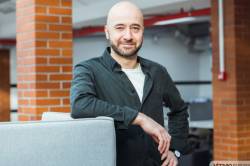Researchers often know their calling since childhood. Did the same happen to you?
From the start, I was interested in physics and mathematics; I was good at solving problems in these fields; therefore, I was accepted into a specialized course at Novosibirsk State University in the ninth grade. And then, in my final year, I became absolutely certain I made the right choice. At that moment, I discovered Surely You're Joking, Mr. Feynman! This is the autobiography of Richard Feynman, a pioneer in quantum electrodynamics, in which he talked about not only science but also his personal life – such as how he painted and played bongo drums in his spare time. His example inspired and ultimately convinced me that it’s possible to be a cool scientist, not a boring nerd in a coat.
And what was your plan?
I applied to the Moscow Institute of Physics and Technology (MIPT), but the rest was pure fate. This is a bizarre story! I failed to get a tuition-free position because of a single point, so I had to settle for a fee-based one. Back then, there were no online bank transfers, so I had to go to the bank to pay my tuition. So, I came to a bank in Moscow to make the transfer, and there was a big bank failure due to the weather. Surely, I could pay later, but I thought about it again and realized that Novosibirsk State University (NSU) that I already knew was just as good a choice as MIPT; and I was able to get in thanks to winning an NSU contest.
My university, like the other 38 institutes of the Siberian Branch of the Russian Academy of Sciences, is conveniently located in a separately-standing university town, as opposed to MIPT, which has campuses scattered throughout Moscow. What I also liked is that I could easily visit my fellow researchers to check what they were working on. As a student, I was able to work at four or five laboratories on several projects involving semiconductors, optics, and the Siberian Ring Photon Source or SKIF, i.e. a laser complex for free electrons designed to generate a new synchrotron radiation source. SKIF is a universally-applicable megascience facility for research in biology and medicine, chemistry and catalysis, and next-gen energy. Potentially, it can be utilized to create new composite materials and thin films, as well as study the fundamental properties of matter.

The university town in Novosibirsk. Credit: Starover64 / photogenica.ru
I know you’ve studied at Paris-Saclay University’s Institute of Optics. How did you get there and what did you take from this experience?
Just so you know, universities are no apex of the educational system in France; there are the so-called higher engineering schools which are ranked higher than universities. As a rule, the country’s citizens can enroll at universities and study there for free, whereas engineering schools require applicants to prepare for future studies for three years and then compete for tuition-free and fee-based positions.
I got into Paris-Saclay University and left for France for two years as part of my double-degree Master’s program. What I noted was different about the French education system is that:
-
Degree programs take three years to complete (I started with the second year, though);
-
Educational courses last not a whole semester but only a half, and they seem more packed and intense;
-
As opposed to Russian universities where students start to work at laboratories during their studies, French students have to first take courses and only then start their paid internships at a laboratory that are about several months long.
First, I worked at the university for three months and studied biosensors based on surface plasmons. Then, I moved to the R&D laboratory at the company Amplitude that creates high-power short-pulse lasers; I worked in this field for six months.

Alexey Kokhanovskiy. Photo by Dmitry Grigoryev / ITMO.NEWS
And how did you end up in St. Petersburg and at ITMO?
When I got back from France, I worked for another seven years at the department of laser physics and innovative technologies at my alma mater. There, I got to work with ultrashort fiber lasers and numerical modeling methods, took part in establishing an experimental laboratory related to the use of machine learning in fiber lasers, worked on my own projects, and defended my PhD thesis.
But in 2018, I got bored and switched to fiber sensors together with my colleagues from different universities and posted my CV on HeadHunter (a popular Russian job search platform – Ed.) just for fun. I just wondered what might happen. And that’s how I met Andrey Bogdanov, an associate professor at ITMO’s Faculty of Physics, and Mikhail Petrov, a senior researcher at ITMO’s Faculty of Physics.
At the same time, I received my international talent visa and could leave for Aston University in the UK, but I decided to stay in Russia. I was won over by the atmosphere and the opportunity to work with students. If you’re a postdoc or a PhD in the UK, you’re unlikely to have students on your team. And at ITMO, there are lots of talented students , especially from St. Petersburg Lyceum 239. They’re partially involved in projects, which helps get the result quicker and provides them with hands-on experience.
Tell us more about your projects at ITMO.
I work in the field that I indicated in my ITMO Fellowship application: machine learning applications in photonics. Now, I am working on computational models of ML applications for the development of metasurfaces and photonics devices, and after that I am planning to move on to experimental setups for quick implementation of ML into the work of our lab.
For instance, the project I developed with Alexander Khvatov (the head of ITMO’s Laboratory for Composite AI – Ed.) won in the open call within ITMO’s 2030 Development Strategy – we will now be receiving up to 20 million rubles annually to fund our project on fundamental AI models for neuromorphic photonics.
How would you describe neuromorphic photonics to someone unfamiliar with the field?
The majority of modern computers use the architecture developed by the American researcher John von Neumann in the 1940s. Its key principle is in storing programs and data in a shared memory space. This solution can be used for all kinds of tasks we are used to performing on our computers these days: from accounting reports and modelling physical experiments to writing texts or code.
However, this architecture isn’t really suitable for neural networks, image recognition, big data processing, or other computation-intensive tasks. First, as programs and data are stored together, they are transmitted to the processor on the same bus, which hinders the exchange of data. Second, tasks are mainly performed consecutively and not in parallel, which also decreases the architecture’s efficiency. Finally, the von Neumann architecture relies heavily on the processor, while the memory has a high energy consumption – for instance, at this point major IT companies are already planning to use nuclear energy to support data centers.
An alternative to the von Neumann architecture are optical neuromorphic computers. They model the structure of the human brain, transmit data with photons instead of electrons, and are capable of parallel data processing, activating the necessary neurons when needed. Thus, they are more efficient and require less energy for data processing, neural network operation, and complex system modeling.

Credit: Jirsak / photogenica.ru
What are you planning to do within the project?
One of our ideas is to use optical resonance metasurfaces as layers of a neural network. With the help of resonance effects, we can localize optical fields, achieving significant nonlinear effects at lower energies. Nonlinear functions are crucial in the majority of computational algorithms.
To design a neuromorphic computer, we will first need to study the effects of thermodynamics, optics, and phase changes on different scales (nanometers, millimeters, and centimeters) within the device. Conventional methods make such multitudes of computations tedious, so to design neuromorphic computers, Alexander Khvatov and I will be using computational models of neuromorphic computers based on AI algorithms. Instead of texts, they will be simulating various physical effects and predicting the physical fields suitable for the selection of geometric and other properties of the future device.
What are the practical benefits of your project?
At the moment, it’s difficult to develop optical computers that can truly compete with their electronic counterparts. This research is conducted with a ten-year vision. Some additional results closest to practical implementation could be the development of metasurfaces for optical processing of images. For instance, the design for hyperspectral cameras used for environmental monitoring.

Credit: do_rayaki_.outlook.co.th / photogenica.ru
This isn’t the only project where you work with AI, right?
Yes, I am also using machine learning in a new field for me, which is optical and mechanical manipulation of resonance perovskite particles. Optical tweezers are quite a developed technology, loved particularly by biologists because it can be used to control and study various biological objects, including cells, bacteria, DNA molecules, and proteins. Resonant particles, with sizes comparable to their wavelengths, are part of complex effects related to light diffraction – these effects hinder the use of optical tweezers. This can be resolved by tackling the reverse task and designing a more complex beam. Using machine learning methods, we can create a wave front that will capture resonant particles. This is a potential new instrument for positioning nano- and microobjects on various photonic integrated circuits that are becoming more and more popular.
At the start of our conversation, you mentioned Richard Feynman, whose biography convinced you to be a physicist. Has your perception changed all these years down the line, after you’ve seen things from the inside? Is this vision of a scientist true for you now? What inspires you in your work?
Such scientists do exist now, even though it can be hard in our modern world. I don’t know if you can learn to be one, but I know that it’s important to find pleasure in the process, not in your results. The pride and joy of publishing your first paper or securing your first grant fades away, and the next ones feel like a routine. What is key for doing science in the long term is enjoying the ideas in your head and the process of their implementation.








